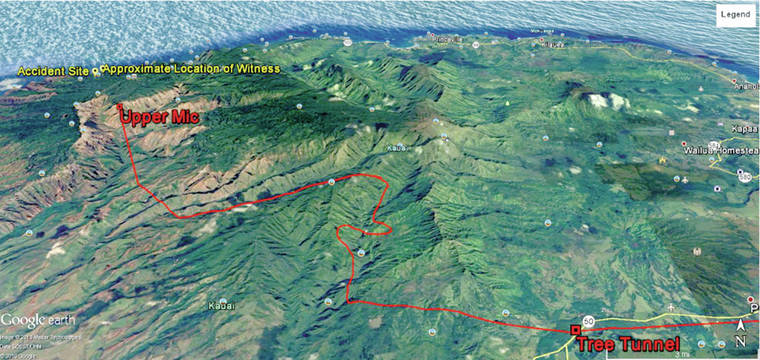LIHUE — Safari Helicopters pilot Paul Matero flew the route of the fatal Dec. 26 tour flight successfully seven times the day of the crash that killed all passengers aboard the Airbus AS350 B2 chopper.
It was during his eighth and last 50-minute flight of the day that the helicopter collided with a north-facing ridge at an elevation of 3,003 feet, fell 100 feet, and landed in flames on the slope.
Wednesday, the National Transportation Safety Board released its preliminary accident report with those details and other new information uncovered during their ongoing investigation.
That report indicates an unnamed witness to the accident, a person who was on the Nualolo Trail that runs along the crash site ridge. The witness was about 1.75 miles up the trail and said weather conditions were at 20-feet visibility with rain and fog.
Kauai Police Department also confirmed positive identities of the pilot and passengers aboard the helicopter Wednesday, saying new DNA technology called The Applied Biosystems RapidHIT ID System expedited the process.
“The findings we made would have typically taken weeks, but we were able to complete them in-house within a short period of time so that we could bring some sense of closure to the families and friends of the victims,” said KPD Chief Todd G. Raybuck in the Wednesday announcement.
On Dec. 26, the Safari Helicopters tour departed from Lihue with six passengers: a Swiss family that included 50-year-old Sylvie Winteregg, 49-year-old Christophe Winteregg, 13-year-old Alice Winteregg and 10-year-old Agathe Winteregg. The other two passengers were confirmed to be 47-year-old Amy Gannon and 13-year-old Jocelyn Gannon of Madison, Wisc.
According to the Associated Press, the pilot, Matero, did not have an instrument rating, which allows pilots to fly at night and in bad weather relying entirely on the helicopter’s flight instruments, according to the Federal Aviation Administration.
A lawyer who has handled several helicopter crashes in Hawaii told The Associated Press shortly after the crash that the nature of helicopter tours requires them to fly by visual flight rules.
“Most of the pilots that fly tour helicopters in Hawaii either don’t have an instrument rating or their instrument rating isn’t current,” said Ladd Sanger, the Texas-based aviation attorney and helicopter pilot. “When you have dynamic weather conditions, where you have clouds and winds, it might be more prudent not to fly in those conditions.”
Instrument-only tours would require a flight plan and altitude that would not be conducive to sightseeing, Sanger said.
There wasn’t any flight-tracking technology on board the helicopter that day either, but typical tour routes take passengers southwest toward Tree Tunnel and then over Waimea Canyon before heading out to the Napali Coast.
Matero was radioing in his location at intervals during that flight — once at 4:32 reporting the flight tour start time, shortly after to report his location at Tree Tunnel and then again at 4:45 p.m., reporting the tour was at “Upper Mic,” indicating he was leaving Waimea Canyon and heading toward Napali.
But after that, radio communication ended.
At 5:31 p.m., 10 minutes after the helicopter was due to arrive back, Safari Helicopters initiated flight-locating procedures and an extensive search was initiated.
The crash site was found within Kokee State Park on Dec. 27 at 9:30 a.m. All of the helicopter’s major components were located within the debris field, according to NTSB, and the wreckage was “largely consumed by a post-crash fire.”
The closest weather station to the Nualolo Ridge crash site is at Barking Sands Pacific Missile Range Facility, about nine miles southwest of the site.
A report from 5:56 p.m. on Dec. 26 observed wind from 310 degrees at 12 knots, gusting to 15 knots, 10 statute miles visibility, few clouds at 1,200 feet, broken clouds at 3,400 feet and 4,700 feet, and overcast clouds at 6,000 feet.
The weather station also reported the temperature at 70 degrees, dew point at 57 degrees and an altimeter setting of 29.9 inches.
Hawaii Congressman Ed Case, a Democrat who represents urban Oahu, who introduced the “Safe and Quiet Skies Act” in 2019 calling for stricter regulations on commercial tour operations, issued a statement Wednesday after the NTSB report was released, saying the report reinforces safety concerns about the industry.
“The tragedy is not only the loss of life but the industry’s position, apparently supported by the FAA, that current regulation is sufficient,” Case said. “That is an open invitation to further tragedies that very well might strike not only those in the air by the million-plus on the ground that they fly over repeatedly every day.”





